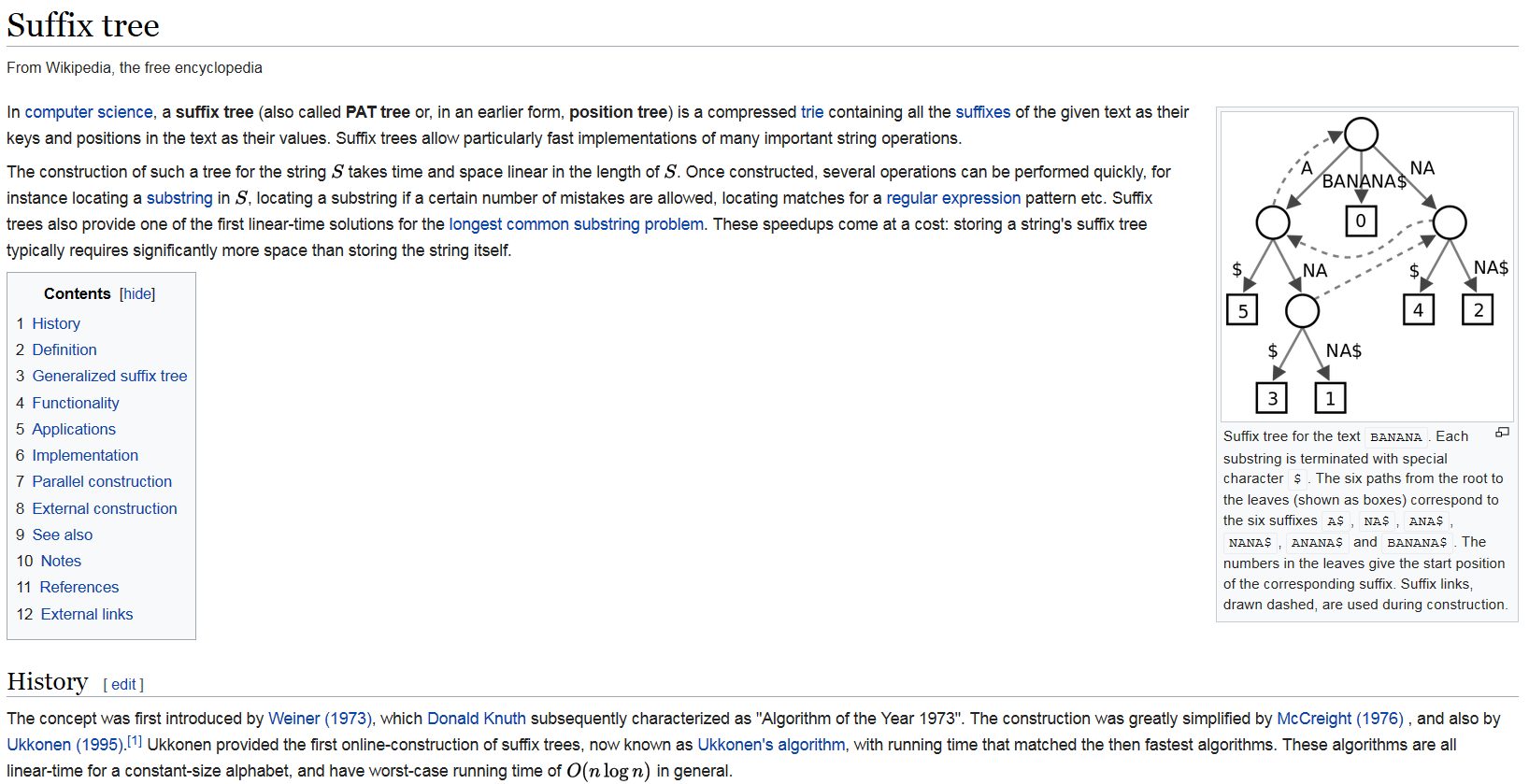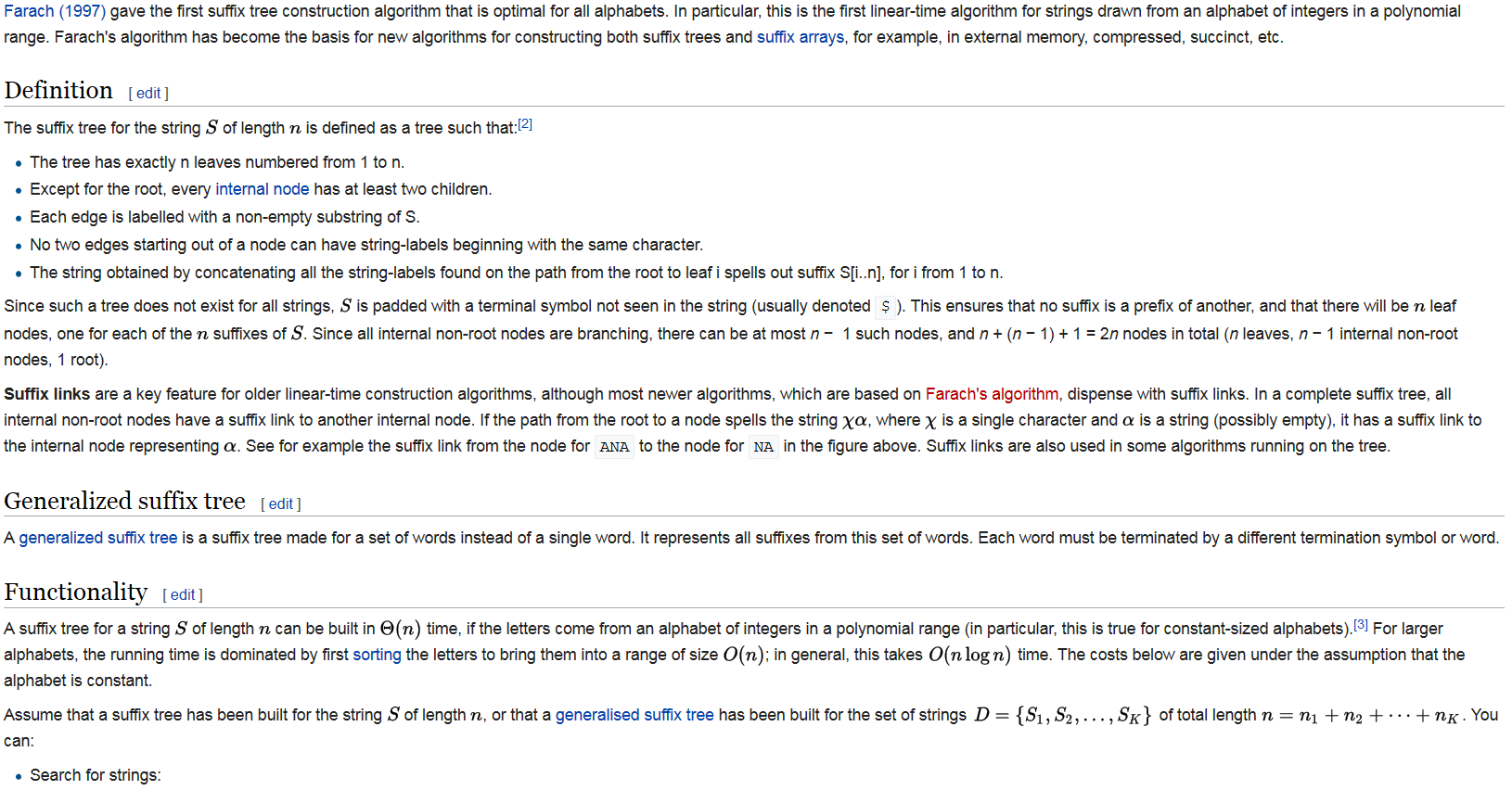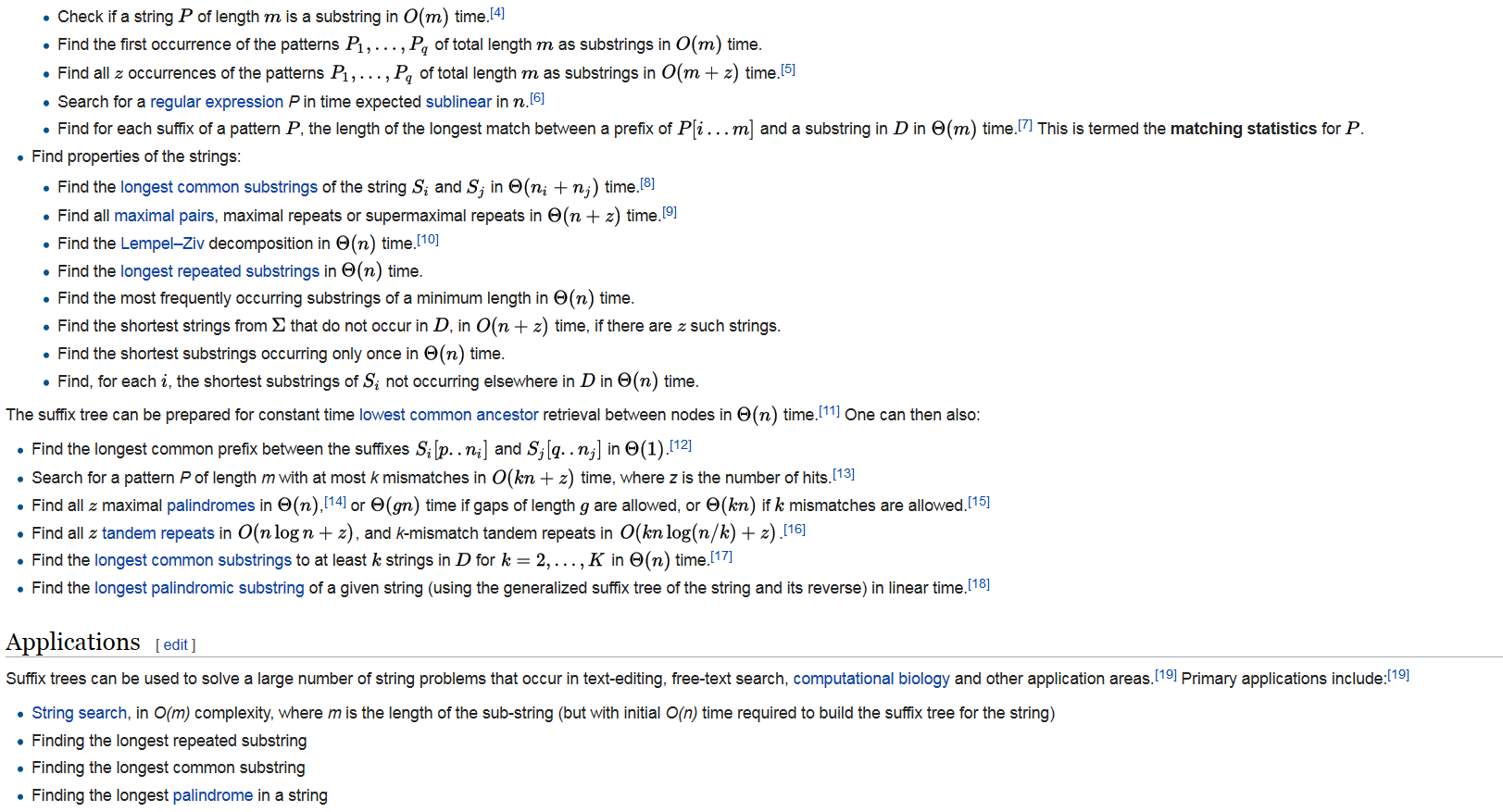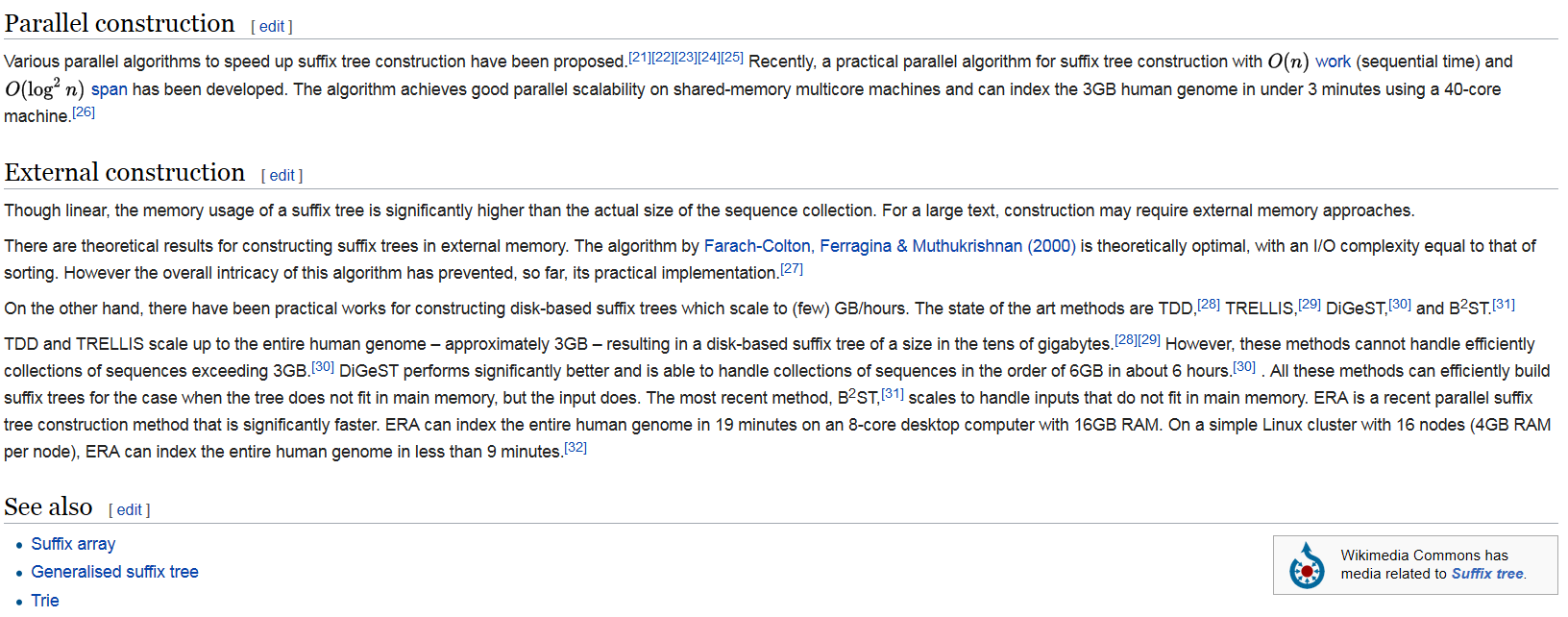这一节主要简单讨论几个跟字符串相关的问题,主题可能会在后面陆续增加。
子串问题用的最多的方法就是动态规划算法和后缀树(见文尾)、Trie。当然其他如hash table,堆等等也需要考虑。有时也可能要配合MAP使用。
1 字符串精确匹配
1.1 KMP算法
KMP主要是利用模式串的最大相同后缀前缀长度。有了模式串在各个位置的这个长度,当与目标串在某个位置不匹配时,可以跳过模式串的这个长度的距离,避免重复的字符串比较。模式串的最大相同后缀前缀长度序列的构建,其实跟后面字符串匹配类似,只是把目标串换成了自己。
详情参照“从头到尾彻底理解KMP”:http://www.cnblogs.com/zhangtianq/p/5839909.html
1.2 连续子串
单个或多个字符串的最长连续重复子串:后缀树
重复次数达到k次的子串:后缀树
最长回文子串:动态规划,Manacher法
2 字符串模糊匹配
2.1 k-近似匹配(允许k个不匹配):
字符串S和P的编辑距离k:动态规划,dist[i][j] = min(dist[i-1][j] + 1, dist[i][j-1] + 1, dist[i-1][j-1] + (S[i]==P[j])?0:1)
做一下改进用于k-近似匹配,参考 “动态规划 近似串匹配”。主要区别是第一行的初始值不一样。算完整串的编辑距离,S[i]与P的空子串的编辑距离是i,而k-近似匹配时,因为S的子串可以从任意位置开 始,所以初始编辑距离为0。

或者通过后缀树,查找节点的最近公共父节点(待考)
2.2 固定空隙长度子串(k个%, maximal gapped motifs)
后缀树相关(待补充)
2.3 随机空隙长度子串(*)
动态规划:字符串S和模式p,当p[j]==‘*’,dp[i][j]=1 if dp[i][j-1] or dp[i-1][j-1]。若此时dp[i][j]==1,则dp[i~n][j]=1
2.4 最长公共子序列LCS
类似上面编辑距离, A和B的LCS[i][j] = (A[i]==B[j])? 1+LCS[i-1][j-1] : max(LCS[i-1][j], LCS[i][j-1]),
3 词频统计
Trie(前缀树/字典树)及其应用 应用场景3
其他参考
后缀树及模式匹配 https://wenku.baidu.com/view/75ae114cc850ad02de804110.html
“in the search of motifs (and other hidden structures)”:http://www.doc88.com/p-9923369128588.html
维基百科“Suffix tree”:https://en.wikipedia.org/wiki/Suffix_tree
http://blog.sina.com.cn/s/blog_a02991400101gl3o.html
Suffix tree





Notes
- Giegerich & Kurtz (1997).
- http://www.cs.uoi.gr/~kblekas/courses/bioinformatics/Suffix_Trees1.pdf
- Farach (1997).
- Gusfield (1999), p.92.
- Gusfield (1999), p.123.
- Baeza-Yates & Gonnet (1996).
- Gusfield (1999), p.132.
- Gusfield (1999), p.125.
- Gusfield (1999), p.144.
- Gusfield (1999), p.166.
- Gusfield (1999), Chapter 8.
- Gusfield (1999), p.196.
- Gusfield (1999), p.200.
- Gusfield (1999), p.198.
- Gusfield (1999), p.201.
- Gusfield (1999), p.204.
- Gusfield (1999), p.205.
- Gusfield (1999), pp.197–199.
- Allison, L. "Suffix Trees". Retrieved 2008-10-14.
- First introduced by Zamir & Etzioni (1998).
- Apostolico et al.
- Hariharan (1994).
- Sahinalp & Vishkin (1994).
- Farach & Muthukrishnan (1996).
- Iliopoulos & Rytter (2004).
- Shun & Blelloch (2014).
- Smyth (2003).
- Tata, Hankins & Patel (2003).
- Phoophakdee & Zaki (2007).
- Barsky et al. (2008).
- Barsky et al. (2009).
References
- Apostolico, A.; Iliopoulos, C.; Landau, G. M.; Schieber, B.; Vishkin, U. (1988), "Parallel construction of a suffix tree with applications", Algorithmica, 3.
- Baeza-Yates, Ricardo A.; Gonnet, Gaston H. (1996), "Fast text searching for regular expressions or automaton searching on tries", Journal of the ACM, 43 (6): 915–936, doi:10.1145/235809.235810.
- Barsky, Marina; Stege, Ulrike; Thomo, Alex; Upton, Chris (2008), "A new method for indexing genomes using on-disk suffix trees", CIKM '08: Proceedings of the 17th ACM Conference on Information and Knowledge Management, New York, NY, USA: ACM, pp. 649–658.
- Barsky, Marina; Stege, Ulrike; Thomo, Alex; Upton, Chris (2009), "Suffix trees for very large genomic sequences", CIKM '09: Proceedings of the 18th ACM Conference on Information and Knowledge Management, New York, NY, USA: ACM.
- Farach, Martin (1997), "Optimal Suffix Tree Construction with Large Alphabets" (PDF), 38th IEEE Symposium on Foundations of Computer Science (FOCS '97), pp. 137–143.
- Farach, Martin; Muthukrishnan, S. (1996), "Optimal Logarithmic Time Randomized Suffix Tree Construction", International Colloquium on Automata Languages and Programming.
- Farach-Colton, Martin; Ferragina, Paolo; Muthukrishnan, S. (2000), "On the sorting-complexity of suffix tree construction.", Journal of the ACM, 47 (6): 987–1011, doi:10.1145/355541.355547.
- Giegerich, R.; Kurtz, S. (1997), "From Ukkonen to McCreight and Weiner: A Unifying View of Linear-Time Suffix Tree Construction" (PDF), Algorithmica, 19 (3): 331–353, doi:10.1007/PL00009177.
- Gusfield, Dan (1999), Algorithms on Strings, Trees and Sequences: Computer Science and Computational Biology, Cambridge University Press, ISBN 0-521-58519-8.
- Hariharan, Ramesh (1994), "Optimal Parallel Suffix Tree Construction", ACM Symposium on Theory of Computing.
- Iliopoulos, Costas; Rytter, Wojciech (2004), "On Parallel Transformations of Suffix Arrays into Suffix Trees", 15th Australasian Workshop on Combinatorial Algorithms.
- Mansour, Essam; Allam, Amin; Skiadopoulos, Spiros; Kalnis, Panos (2011), "ERA: Efficient Serial and Parallel Suffix Tree Construction for Very Long Strings" (PDF), PVLDB, 5 (1): 49–60, doi:10.14778/2047485.2047490.
- McCreight, Edward M. (1976), "A Space-Economical Suffix Tree Construction Algorithm", Journal of the ACM, 23 (2): 262–272, CiteSeerX 10.1.1.130.8022
 , doi:10.1145/321941.321946.
, doi:10.1145/321941.321946. - Phoophakdee, Benjarath; Zaki, Mohammed J. (2007), "Genome-scale disk-based suffix tree indexing", SIGMOD '07: Proceedings of the ACM SIGMOD International Conference on Management of Data, New York, NY, USA: ACM, pp. 833–844.
- Sahinalp, Cenk; Vishkin, Uzi (1994), "Symmetry breaking for suffix tree construction", ACM Symposium on Theory of Computing
- Smyth, William (2003), Computing Patterns in Strings, Addison-Wesley.
- Shun, Julian; Blelloch, Guy E. (2014), "A Simple Parallel Cartesian Tree Algorithm and its Application to Parallel Suffix Tree Construction", ACM Transactions on Parallel Computing.
- Tata, Sandeep; Hankins, Richard A.; Patel, Jignesh M. (2003), "Practical Suffix Tree Construction", VLDB '03: Proceedings of the 30th International Conference on Very Large Data Bases, Morgan Kaufmann, pp. 36–47.
- Ukkonen, E. (1995), "On-line construction of suffix trees" (PDF), Algorithmica, 14 (3): 249–260, doi:10.1007/BF01206331.
- Weiner, P. (1973), "Linear pattern matching algorithms" (PDF), 14th Annual IEEE Symposium on Switching and Automata Theory, pp. 1–11, doi:10.1109/SWAT.1973.13.
- Zamir, Oren; Etzioni, Oren (1998), "Web document clustering: a feasibility demonstration", SIGIR '98: Proceedings of the 21st annual international ACM SIGIR conference on Research and development in information retrieval, New York, NY, USA: ACM, pp. 46–54.
External links
- Suffix Trees by Sartaj Sahni
- NIST's Dictionary of Algorithms and Data Structures: Suffix Tree
- Universal Data Compression Based on the Burrows-Wheeler Transformation: Theory and Practice, application of suffix trees in the BWT
- Theory and Practice of Succinct Data Structures, C++ implementation of a compressed suffix tree
- Ukkonen's Suffix Tree Implementation in C Part 1 Part 2 Part 3 Part 4 Part 5 Part 6